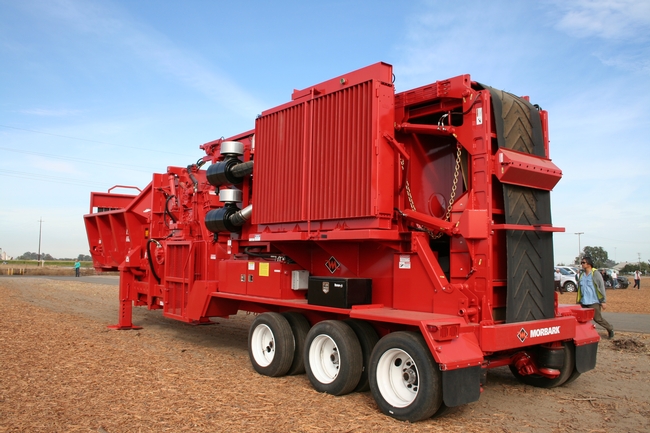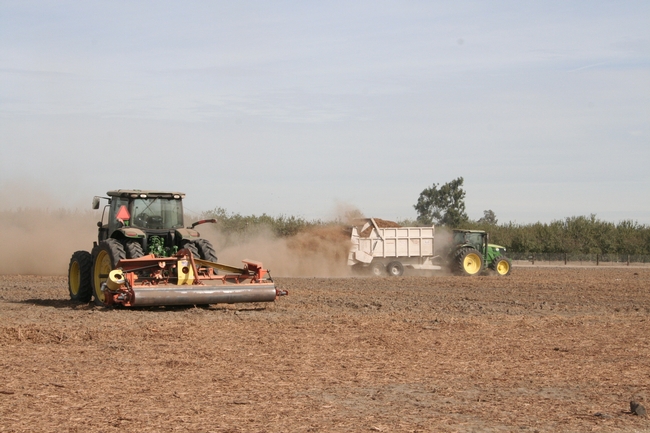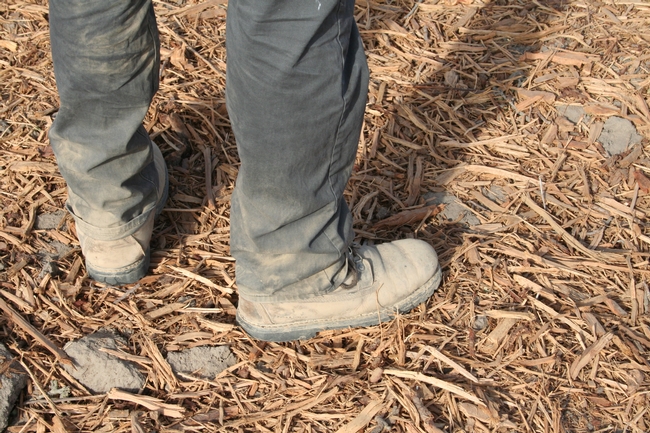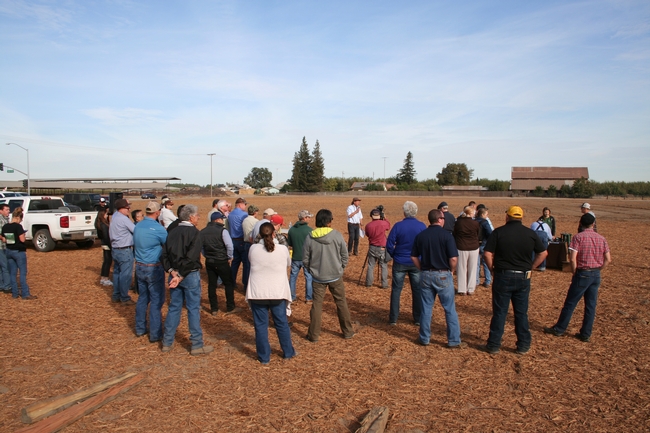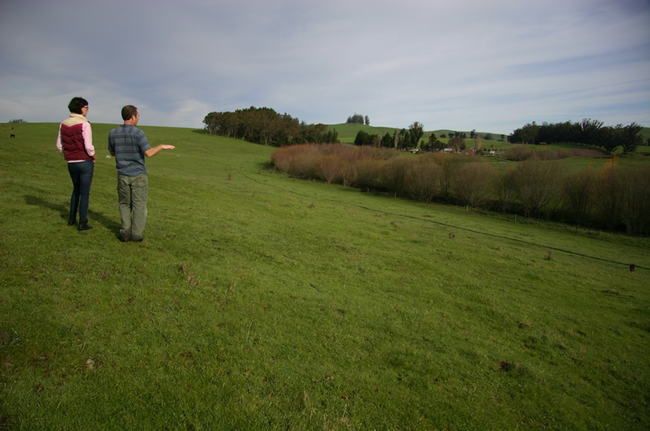Posts Tagged: carbon sequestration
Planet-friendly orchard recycling makes money sense
The numbers are beginning to trickle in confirming UC Cooperative Extension advisor Brent Holtz' hunch. Chipping and returning expired almond orchards into the soil where they grew is not only environmentally sound, it is economically smart.
(View a three-minute video of the machinery in action at the end of this post.)
After about 20 years, almond orchards' productivity and vigor begin to decline. Most farmers remove the old trees and plant younger, more vigorous replacements to keep up almond production.
In the past, old trees were easily and cheaply disposed of: they were pushed into a pile and set on fire. Air quality regulations have all but eliminated the practice.
At first, grinding the trees and sending the chips to a co-generation plant was a farmer's preferred option. The companies that used biomass for electricity generation paid an acceptable sum – about $600 per acre – for the wood chips, which helped offset the cost of chipping and hauling the trees off the property.
However today, electrical utilities are looking for clean, renewable energy sources like wind and solar.
“Cogeneration plants burn wood biomass, which still releases carbon dioxide and methane into the atmosphere,” Holtz said. “Many are losing contracts and shutting down.”
Holtz sought another cost-effective alternative, and believes incorporating the wood into the orchard floor may be the answer. Although initially expensive, adding $400 per acre to the $600-per-acre cost of chipping the old trees, the organic matter and nutrients released by the woodchips over time appear to boost yield to a level that covers a chunk of the cost.
In preliminary research, Holtz found that almond orchards where old wood was incorporated into the soil were averaging about 1,800 pounds of meat nuts per acre, while the orchard where old trees had been burned averaged 1,600 meat nuts per acre.
“Almonds sell for about $2 to $3 per pound. To have a 200-pound average yield increase per acre, you've made up the cost of incorporating the wood in just one year,” Holtz said. “It would be even more affordable if farmers can sell carbon credits for the biomass that they sequester in the ground.”
Holtz recently demonstrated two approaches for incorporating almond trees into the soil. The first, which was also used in the study eight years ago at the UC Kearney Agricultural Research and Extension Center in Parlier, is a 50-ton rock crusher called the Iron Wolf. It lumbers down the tree row, grinding up whole trees in place, then reverses over the mangled wood to incorporate it into the ground.
“We thought this one-machine process was the answer,” Holtz said.
G & F Ag Services in Ripon, which has made a business of chipping and hauling almond wood to a co-generation plant, conceived another plan. It modified a manure spreader to spray ground-up wood chips across the orchard floor. Holtz worked with Manteca farmer Louie Tallerico to give the new process a spin.
“This required five different machines working together compared to one Iron Wolf. In this process, the trees have to be excavated by an excavator, then hauled to the wood chipper with a front-end loader. The trees have to be fed into the wood chipper, then the wood chips have to be spread on the orchard floor,” Holtz said. “Another machine, a disk or roto tiller, incorporates the chips into the soil.
The five machines combined are a tremendous time saver.
“The Iron Wolf could do about two acres per day,” Holtz said. “This process can do 15 or 20 acres per day.”
Tallerico opened his farm for a field day in October to demonstrate parts of the process to other farmers and industry representatives. Participants stood on layer of fresh-cut wood chip mulch where a full-grown almond orchard stood just weeks before. The spreader demonstrated the ease with which the wood chips are dispersed evenly across the orchard floor, and a tiller mixed the wood chips into the soil.
The Tellarico orchard will now be the site of research – funded by the California Almond Board – to be conducted by Holtz and a team of scientists interested in documenting the growth and development of the new almond orchard among the remnants of its predecessor.
“In the previous study, three years after incorporating the old trees into the soil we started to see the nutrient benefit,” Holtz said. “This was done at Kearney, where we incorporated a peach orchard that had about 30 tons of organic matter per acre. Almond trees are larger, so here we have 86 tons of organic matter being returned to the soil.”
In the new study, the scientists will determine whether the nutrient benefits found in early research still hold true, whether the wood chips in the soil stunt the new orchard or boost its growth, whether the new orchard suffers from replant disease, and the fate of good and bad nematodes (tiny soil-borne worms) in the new orchard.
“We will also study the carbon budget and continue the life cycle assessment of almond with this practice, to better understand the benefit of these processes,” Holtz said.
Counties can offset greenhouse gas emissions with stream restoration
“We have long known that stream revegetation improves wildlife habitat and enhances water quality, but that fact that the vegetation and trapped sediment capture carbon underscores the importance of this conservation practice,” said David Lewis, a UC Agriculture and Natural Resources (UC ANR) watershed management advisor for Marin, Sonoma and Napa counties.
Going back to the time when Gen. Mariano Guadalupe Vallejo was running long-horn cattle on a vast tract of land in Alta California, ranchers didn't always understand the value of the trees, shrubs and grasses that grew around rangeland waterways.
Vallejo removed vegetation because it provided a hideout for grizzly bears that attacked his cattle and pilfered hides being tanned. In later years, authorities coached landowners to alter streams and remove plants to increase stream flow and improve flood control.
Beginning in the 1960s, the environmental impacts of removing trees and plants became apparent and public funds were made available to share in the cost of restoring streamside vegetation on private land, said Lewis, who is also director of UC ANR Cooperative Extension in Marin and Napa counties. Over a period of three years, he and a team of UC and local scientists studied the stream revegetation projects that took place from about 1970 to just recently. They documented the carbon sequestration benefits of stream revegetation and calculated the value based on the current market for carbon credits. The results were shared in a report released this month, Mitigating Greenhouse Gas Emissions through Riparian Revegetation.
“In Marin County, for example, the cost per metric ton for carbon dioxide equivalence sequestered with revegetation was $19.75. The carbon market is currently paying about $12.50,” Lewis said. “There is about $7 that we haven't made up. But when you think about the other benefits of riparian restoration – reduced sediment, restored habitat for migratory songbirds and other wildlife – I would bet that value to be much greater than $7.”
Lewis' research will be of interest to county governments as they strive to reduce total greenhouse gas emissions to comply with the requirements of the 2006 California Global Warming Solutions Act (AB 32). The legislation requires California to reduce its greenhouse emissions to 1990 levels by 2020. As part of the law, local governments must write a “Climate Action Plan” to report how they will monitor and track progress in reducing and offsetting greenhouse gas emissions.
“It may make sense for governments and project proponents to invest in creek restoration and other farm conservation practices to reach and surpass their carbon emission reduction goals,” Lewis said.
Through 1990, Marin ranchers restored more than 25 miles of stream with willows, oaks and other trees and shrubs. Those plants trapped sediment contain an estimated 80,265 metric tons of sequestered carbon – an amount equal to emissions from 61,959 passenger cars in one year.
Lewis estimates there are several hundred miles of unrestored streams in Northern California coastal counties. And the implications of this study have application for rangeland streams throughout California.
“This represents tremendous potential for carbon sequestration,” Lewis said. “And rancher interest in stream restoration has never been higher. Working with the ranchers to plant trees and shrubs along our waterways presents a significant opportunity to offset carbon emissions.”
An initiative to maintain and enhance sustainable natural ecosystems is part of UC Agriculture and Natural Resources Strategic Vision 2025.
Rangelands could offset tons of carbon emissions
With proper management, already productive California rangeland could single-handedly offset the state's carbon emissions, believe researchers involved in The Marin Carbon Project.
The ongoing effort was covered by the San Rafael/Terra Linda News Pointer in connection with a Bioneers Conference taking place Oct 15-17 at San Rafael’s Marin Center.
The Marin Carbon Project was formed to establish the basis for rangeland soil carbon sequestration. Initiated two years ago, the project involves ranchers and researchers representing UC Berkeley, UC Davis, UC Cooperative Extension, Marin Organic, Marin Agricultural Land Trust, Marin Resource Conservation District, the USDA Natural Resources Conservation Service, Nicasio Native Grass Ranch, the Marin County Agriculture Commissioner and the Environmental Defense Fund.
Soil surveys to establish pre-existing levels of carbon in Marin rangeland soils have been completed. This baseline data will allow the accurate assessment of how much carbon improved management practices sequester over time.
For example, project co-founder John Wick told reporter Anna McCarthy that composting wet dairy manure with greenwaste and spreading it on rangelands increases rangeland production and reduces the risk of pathogen runoff into waterways. The practice also "turns the land into a carbon sucking machine," McCarthy wrote.
“It works,” Wick was quoted. “And it works at such a rate, it’s phenomenal.”
A year after adding a half-inch dusting of compost to his rangelands, Wick said the soil yielded 10 tons of carbon per hectare (10,000 square meters).
“That rate, applied on one-third of California’s rangeland, would offset all of California’s emissions every year,” Wick told the reporter.
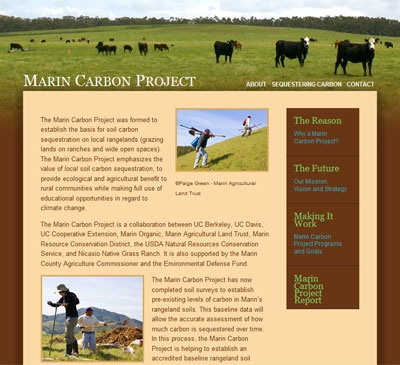
The Marin Carbon Project seeks to document carbon sequestration in rangeland.


